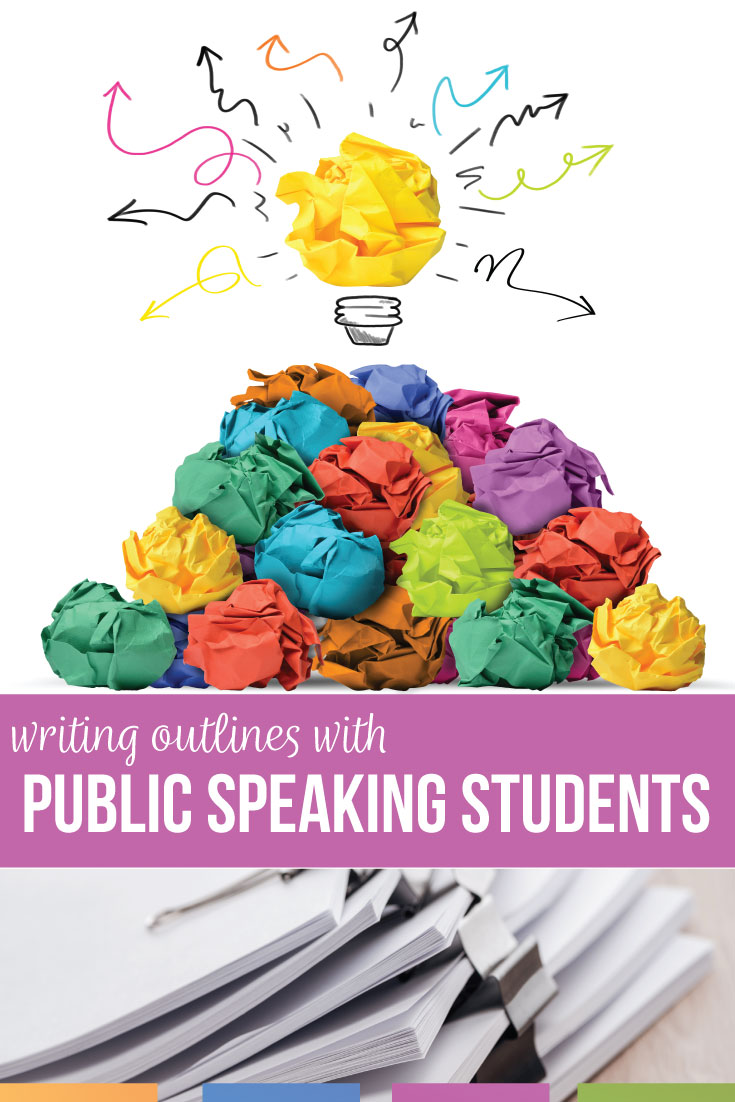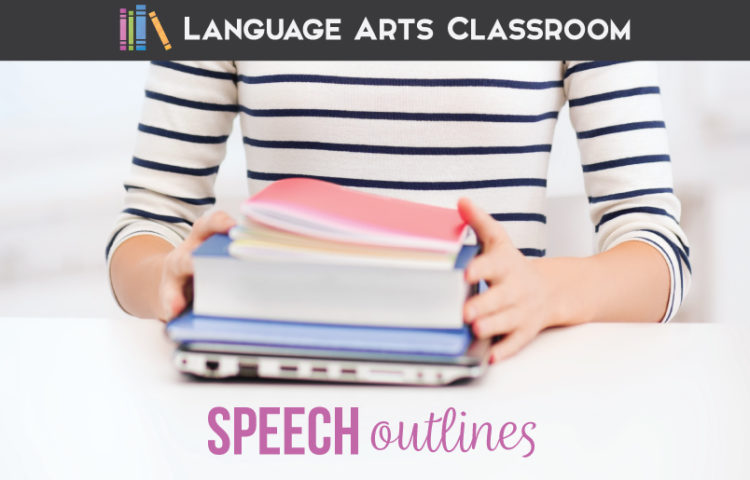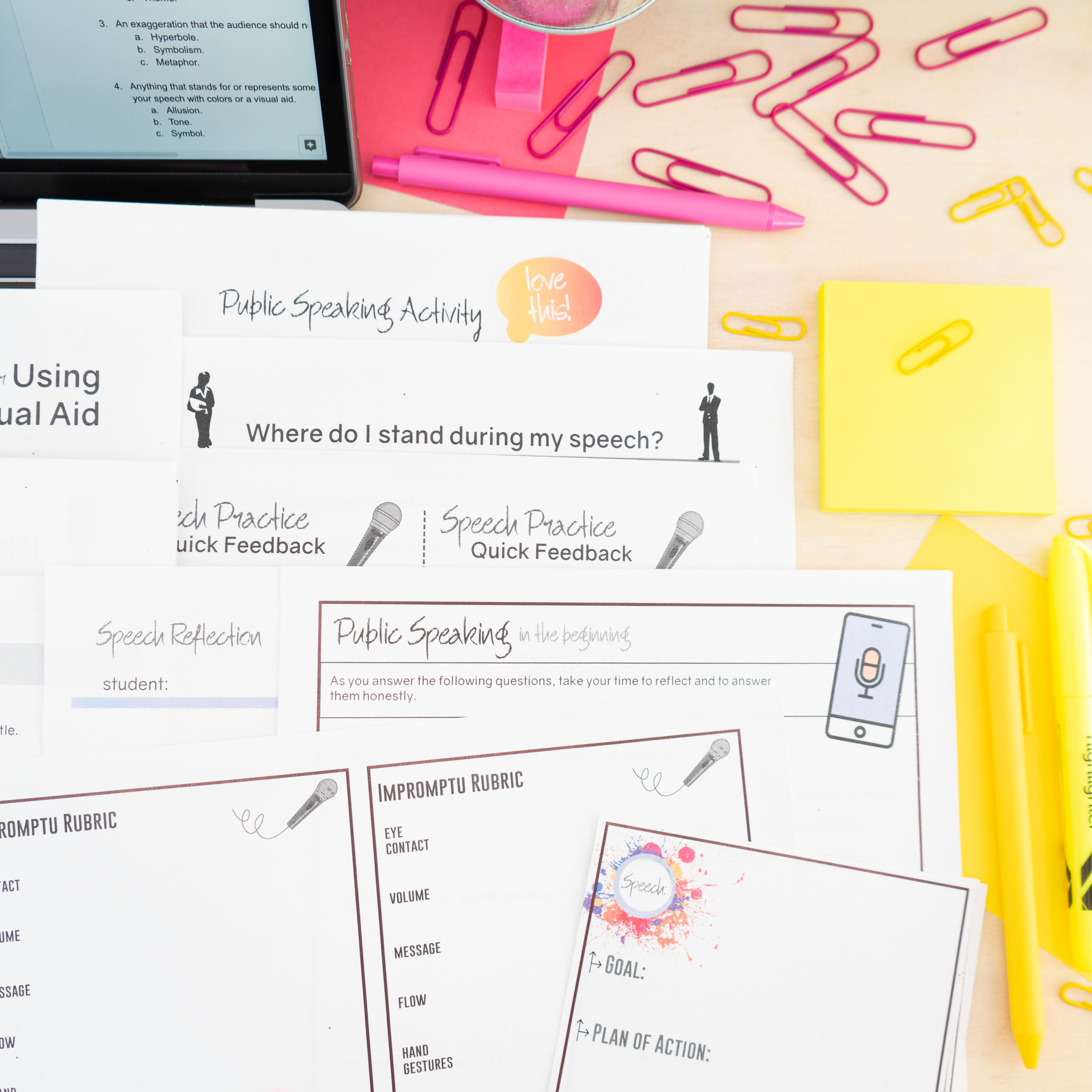Speech outlines for students? How should you design them, especially younger students like middle school public speaking students?
Speech textbooks encourage students to write outlines for their speeches. Since audience do not have the advantage of visually seeing the words, a speech’s organization (preview, transitions, signal phrases) is of the utmost importance. An outline allows students to see each point individually.
Creating speech outlines for students can be tricky though. You want to provide an example, but you don’t want to limit their creativity.
Writing outlines with students is an important activity. Looking at a speech line by line aids in transitions, and in creating a balance of material. An outline is also a working document. As students practice their delivery, they can easily add and subtract from an outline. When I taught middle school speech, I found that designing a speech outline with students calmed nerves and gave students a tool for practicing.
Why is it important for students to create a speech outline before delivering their speeches?
Creating a speech outline helps students organize their thoughts, structure their speech, and ensure a clear flow of ideas. It serves as a roadmap for the speech, helping students stay focused and on track. Additionally, outlines help students remember key points and maintain coherence in their delivery.
What are the benefits of starting with speech outlines for students?
Eventually, public speakers move away from the classic outline—a sort of personalized approach takes over a speech outline template. A successful presentation does not mandate a one-size-fits-all-approach.
Still, for new speakers, a sample speech outline that serves as a mentor text helps. Once they focus on a basic speech outline, they can work on eye contact, vocal variety, body language, visual aids—the other components to consider.
So, to begin, an outline is the preferred design. As the teacher, you must decide which speech outline students should use: sentence or topic. Here are pros and cons when deciding between speech outlines for new speakers.

Sentence Outlines
Pros: A sentence outline gives a polished picture of the speech. Speakers can add sentence transitions, which help an audience more than one word transitions. The speech is typically more developed than a speech from a topic outline.
Students can also read over the speech and get an idea of how the speech will sound. From a topic outline, students will need to develop different parts of the speech each time. With a sentence outline, students will hear the speech in their heads, and it may come naturally to them as they deliver the speech.
Cons: Students who dislike writing struggle with this stage. They may enjoy the different pace of a speech class, but they feel that they are writing papers with an additional step (speaking). Finally, speakers can be reluctant to alter a sentence outline. These outlines are longer, and they may leave a portion that needs work because that one portion interferes with the flow of the entire speech.
Topic Outlines
Pros: The short nature of topic outlines is easy to manipulate. During practice, students can add points, practice, and then move or delete what doesn’t work. It is more a working document—moldable.
Topic outlines don’t take long to write. Because they are short, speakers can spend more time practicing the speech than writing the speech.
Cons: Students can write the subjects and not fully think the talking points for the speech. If they practice a topic outline, they may deliver a strong speech. If students do not practice, a speech given from a topic outline is short. A topic sentence does not force students to think completely through a speech. A speaking experience like that can frustrate.
So….
Thesis, Main Points, Transitions: Choosing an Outline
What do I use? At first, I only used sentence outlines. Students were more prepared, and the longer outlines gave them structure. One time (I can’t remember why), I assigned a topic outline. And? As they progressed, the topic outlines turned into sentence outlines. Some students did not write enough information, but for the those who put forth effort, their outlines were their own, very organized and personalized.
Furthermore, to include all the necessary pieces like a main idea, thesis main points, and on, classes benefit from sample outlines. Therefore, I provide students with outline examples for how-to speeches and narrative speeches. Giving examples builds relationships with students and trust because they see my process.
You can always try both versions with classes, and then decide, or allow students to provide input. When deciding what speech outline is best for your circumstances, consider their need for structure and abilities to create different types of outlines.
Now, my classes write sentence outlines until I feel they are capable of a topic outlines. I give students the goal of eventually writing a topic outline, and they are willing to work toward it.
Would public speaking lessons help you? Sign up below, and they’ll be sent your way, for free.



